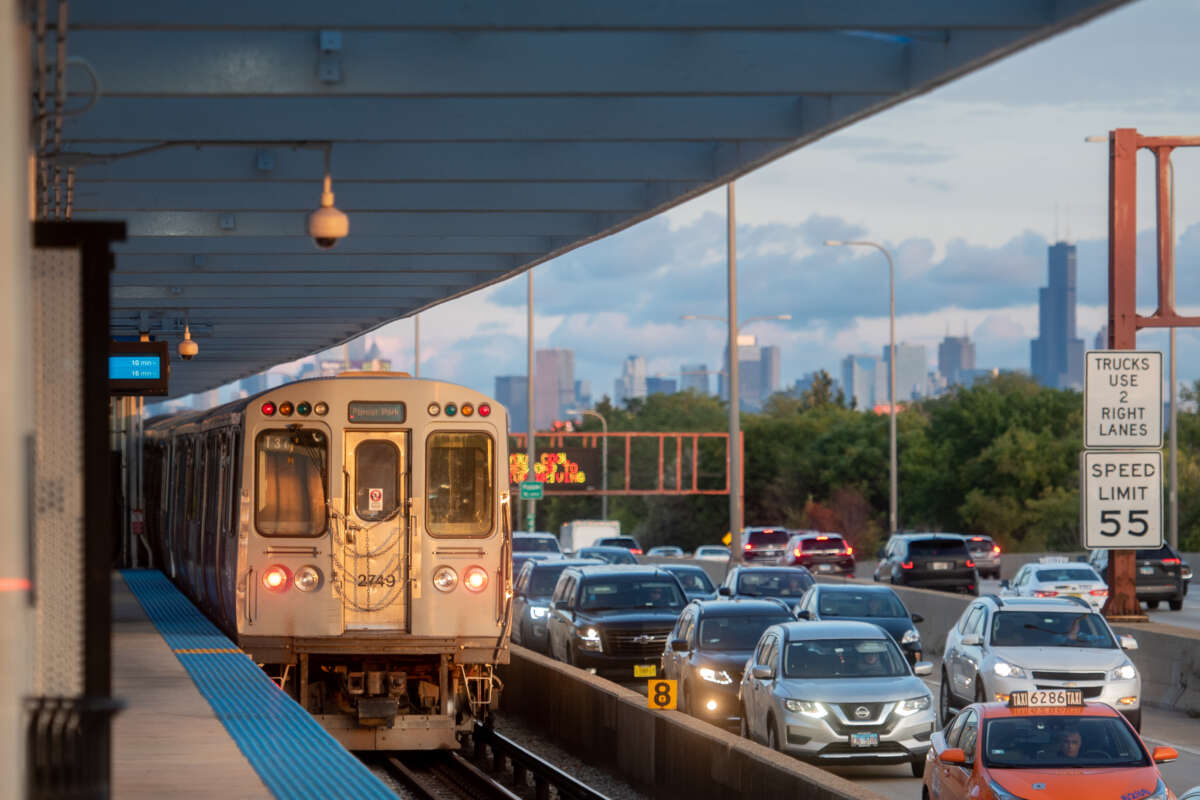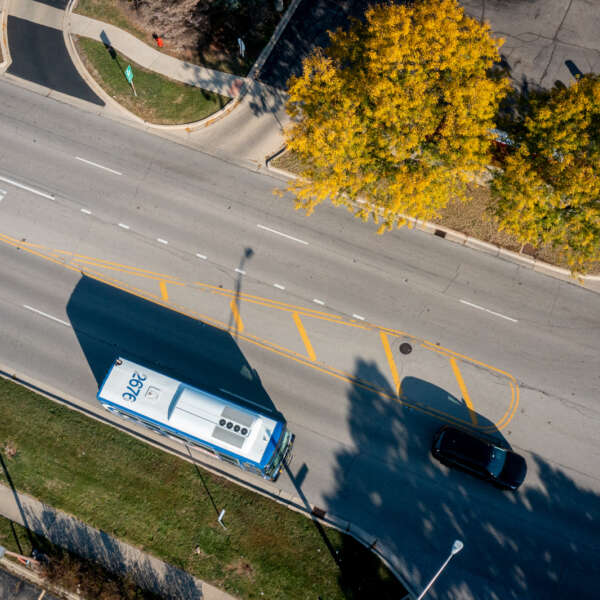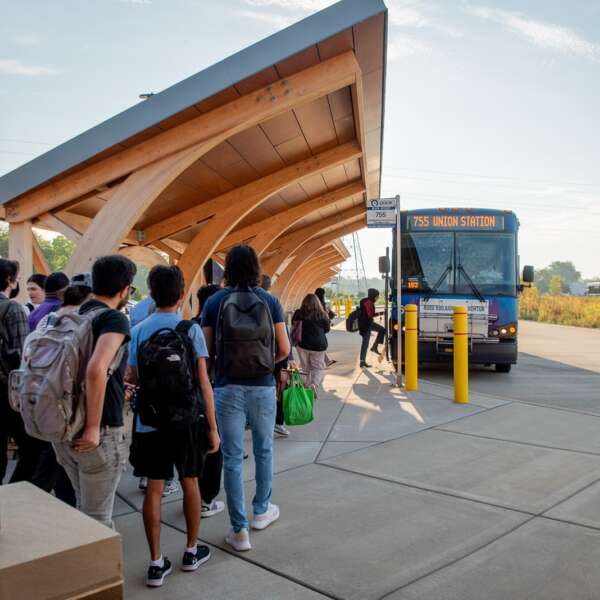A pivotal choice for transit: RTA analysis explores outcome of either falling off the fiscal cliff or investing in transit
August 28, 2024
August 28, 2024

At the RTA’s August board meeting, staff presented new economic impact analyses illustrating two drastically different potential futures for the regional transit system. In the “fiscal cliff” scenario, the $730 million budget gap that the system faces in 2026 when COVID relief funding runs out is not filled. In the “expansion” scenario, a funding solution is reached that provides at least $1.5 billion in additional operations funding for the region’s system. The analyses looked at both scenarios in terms of regional scale impacts on service, people, the economy, and other factors. The work focuses on year one impacts, but downstream impacts would continue to snowball into the future.
The results of this analysis are clear: not investing in transit comes with costs greater than the fiscal cliff itself and they worsen each year as the problem magnifies. Conversely, a robust investment in transit operations will accelerate equitable economic growth and bring in financial returns to the region, paying off the investment quickly. The RTA along with CTA, Metra, and Pace will continue to advocate for the state legislature to advance a funding package in 2025 to ensure seamless operational funding availability in 2026 to not only avert the fiscal cliff, but also to expand our transit operations.
2026 will be a critical pivot point for the region as the remaining COVID relief funding will have been spent, leaving a $730 million budget gap accounting for about 20 percent of the regional transit system’s operating budget. According to the analysis, a 20 percent cut in the regional operating budget can be achieved only with a larger service cut of 30-40 percent. A bus rider in the city will see a 25-minute headway for what used to be 15. In the suburbs, a 45-minute headway becomes over an hour wait for a bus. A Metra line that previously ran 90 trains per day is down to 54. Current momentum of service increase and ridership recovery stalls as residents wouldn’t have access to adequate transit to get around.
On the other hand, if the budget gap is filled and operations funding is increased by another 20 percent, CTA, Metra, and Pace can invest in service increases by 30-40 percent. Frequencies become 10 minutes or less on an urban bus route and 30 minutes or less in the suburbs. A Metra line carrying 90 trains can expand to more than 120.
By falling off the fiscal cliff, the Chicago region could expect a $2.6 billion annual loss in GDP and the loss of 27,000 jobs—not just at the transit agencies but vendors and contractors that support transit. Workers throughout the region could lose out on $1 billion in wages. Direct and indirect impact of transit disinvestment can make the region economically uncompetitive.
Conversely, an expanded transit system would grow the regional economy by $2.7 billion per year and add 28,000 jobs. Workers would take home much of that investment in wages.
In the fiscal cliff scenario, job losses increase the need for assistance programs and unemployment, resulting in an additional $242 million in public assistance costs. Health care costs would increase by $23 million, largely due to more drivers on the road causing increased pollution and traffic crashes.
With expansion, the region saves $192 million in public assistance costs and enjoys $18 million less in health care costs.
Using Remix, a software platform that helps public transportation agencies plan, evaluate, and collaborate on updates to their networks, the RTA analyzed how service cuts would impact job access throughout the region. In neighborhoods farther from the urban core like Roseland and West Ridge, job access shrinks by 32 percent from current levels. These are areas where transit is an equalizer, connecting people to jobs outside their community, but in the fiscal cliff scenario, that would be more difficult.
In Lakeview on the North Side of Chicago, the job access reduction is only 5 percent due to the abundance of transit options and dense development. The impacts, however, would still be substantial. A 40 percent reduction in service would produce dramatic overcrowding at key stations like Belmont where the Red, Brown, and Purple lines come together. Key bus routes like Halsted and Clark wouldn’t have capacity to carry current rider levels. The dense North Side of the city would grind to a halt as more people relied on cars to get around.
Suburban communities would face a similar impact. In Bridgeview in suburban Cook and Waukegan in Lake County, both communities where Pace serves riders and connects to rail, the typical resident would see the number of jobs they can reach on transit reduced by as much as 46 percent, whereas Addison in Cook and Naperville in DuPage would see declines of 9 and 17 percent in job access, respectively. But the 40 percent reduction in service means fewer express trains into the city. Riders could expect crush loads at popular stations like Naperville and Route 59, and suburban workers with access to private vehicles would be more likely to end up on already congested expressways into the city, where they would then have to pay a premium to park.
In a scenario where the regional transit system’s budget gap is not filled, the region would lose $372 million in taxes, $50 million in productivity from time spent sitting in traffic, and $41 million in educational benefit from students lacking transportation to access schools and universities.
An expanded system would see $379 million in tax revenue added, $34 million in productivity saved, and $33 million in educational benefit saved.
In a recent INRIX report, Chicago ranked 5th worldwide and 2nd in the U.S. for congestion, costing the typical driver $1,672 per year in lost time sitting in traffic. The fiscal cliff scenario would add 366 million more vehicle miles to the region’s roads, ensuring greater costs to the economy and public health. Alternatively, the expansion scenario could alleviate congestion, taking 289 million miles of vehicle travel off regional roads.
While these “year one” impacts are dramatic, they will build even more over time for either scenario. Falling off the fiscal cliff will lead to annual, growing revenue shortfalls as service cuts produce even less ridership and thus less fare revenue for the system, which in turn will lead to more and more service cuts. This cycle of service cuts and revenue losses can be referred to as a transit death spiral. But beyond service, GDP, jobs, wages, public assistance, and health care costs are all impacted. Conversely, investment in the transit system will lead to ridership and revenue gains, which would facilitate more service improvements over time.
The RTA is working with policy makers at all levels of government to develop sustainable funding solutions and improve the system for all riders. Join the Transit is the Answer Coalition to help bring about the legislative changes needed to support transit at this pivotal moment.
Subscribe to our Newsletter
Related Articles
 Coalition members provide feedback on ‘Transforming Transit,’ RTA’s vision for improved service and accountability
Coalition members provide feedback on ‘Transforming Transit,’ RTA’s vision for improved service and accountability
Nearly 200 riders, advocates, and other stakeholders met virtually with the RTA on February 11 for the sixth quarterly Transit is the Answer Coalition meetin...
February 20, 2025 Far South Halsted Corridor Study prepares for future Pace Pulse service
Far South Halsted Corridor Study prepares for future Pace Pulse service
An RTA Community Planning project kicked off in late 2023 as a crucial step in bringing Pace Pulse service to Chicago’s south suburbs. The Far South Halsted ...
February 19, 2025 RTA proposes reforms to prioritize capital projects, maximizing impact of funding
RTA proposes reforms to prioritize capital projects, maximizing impact of funding
RTA is proposing a historic restructuring of the region’s transit governance to maximize the impact of new operating funding and ensure all riders experience...
February 5, 2025 RTA proposes reforms to integrate fares, require accountability for faster and more reliable transit
RTA proposes reforms to integrate fares, require accountability for faster and more reliable transit
RTA is proposing a historic restructuring of the region’s transit governance to maximize the impact of any new operating funding and ensure all riders experi...
February 5, 2025 For the third year in a row, regional transit ridership was up by double-digits in 2024
For the third year in a row, regional transit ridership was up by double-digits in 2024
Ridership across the Chicago region’s transit system continued to increase throughout 2024, according to the latest data from CTA, Metra, and Pace. The regio...
January 28, 2025 RTA is seeking $1.5 billion in annual operating funding. What would that mean for your commute?
RTA is seeking $1.5 billion in annual operating funding. What would that mean for your commute?
On January 15, RTA released Transforming Transit, a vision for the regional transit system with $1.5 billion in annual operating funding supported by a stron...
January 28, 2025